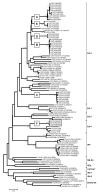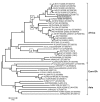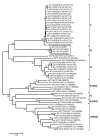Genetic characterization of foot-and-mouth disease viruses, Ethiopia, 1981-2007
- PMID: 19788808
- PMCID: PMC2819860
- DOI: 10.3201/eid1509.090091
Genetic characterization of foot-and-mouth disease viruses, Ethiopia, 1981-2007
Abstract
Foot-and-mouth disease (FMD) is endemic to sub-Saharan Africa. To further understand its complex epidemiology, which involves multiple virus serotypes and host species, we characterized the viruses recovered from FMD outbreaks in Ethiopia during 1981-2007. We detected 5 of the 7 FMDV serotypes (O, A, C, Southern African Territories [SAT] 1, and SAT 2). Serotype O predominated, followed by serotype A; type C was not recognized after 1983. Phylogenetic analysis of virus protein 1 sequences indicated emergence of a new topotype within serotype O, East Africa 4. In 2007, serotype SAT 1 was detected in Ethiopia and formed a new distinct topotype (IX), and serotype SAT 2 reappeared after an apparent gap of 16 years. The diversity of viruses highlights the role of this region as a reservoir for FMD virus, and their continuing emergence in Ethiopia will greatly affect spread and consequent control strategy of the disease on this continent.
Figures







References
-
- Mattion N, König G, Seki C, Smitsaart E, Maradei E, Robiolo B, et al. Reintroduction of foot-and-mouth disease in Argentina: characterisation of the isolates and development of tools for the control and eradication of the disease. Vaccine. 2004;22:4149–62. 10.1016/j.vaccine.2004.06.040 - DOI - PubMed
-
- Cartwright B, Chapman WG, Sharpe RT. Stimulation by heterotypic antigens of foot-and-mouth-disease virus antibodies in vaccinated cattle. Res Vet Sci. 1982;32:338–42. - PubMed
-
- Sahle M, Venter EH, Dwarka RM, Vosloo W. Molecular epidemiology of serotype O foot-and-mouth disease virus isolated from cattle in Ethiopia between 1979–2001. Onderstepoort J Vet Res. 2004;71:129–38. - PubMed
-
- Vosloo W, Bastos ADS, Sangare O, Hargreaves SK, Thomson GR. Review of the status and control of foot and mouth disease in sub-Saharan Africa. Rev Sci Tech Off Int Epizoot. 2002;21:437–49. - PubMed
Publication types
MeSH terms
Grants and funding
LinkOut - more resources
Full Text Sources
Research Materials
Miscellaneous
